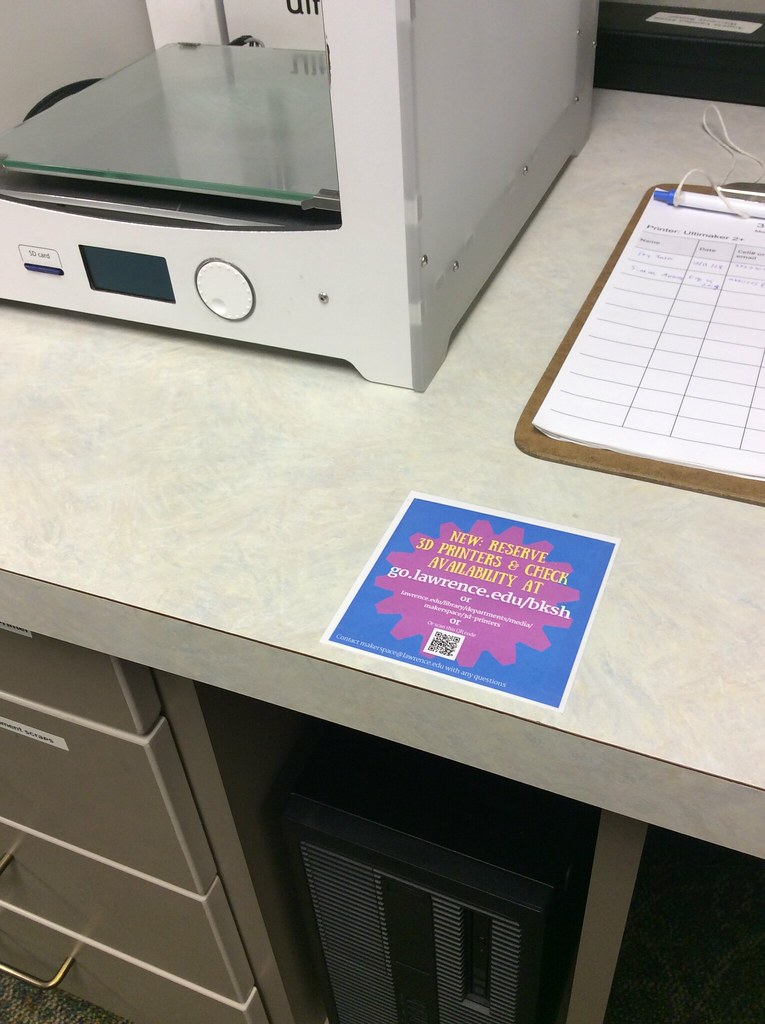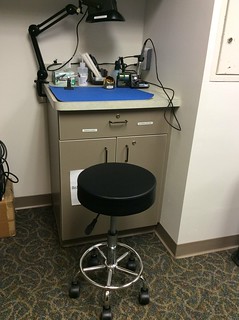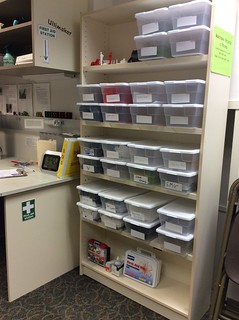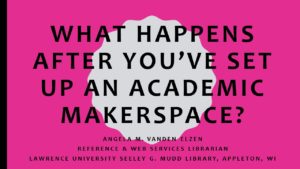 We get asked questions about setting up an academic makerspace by colleagues from other libraries and universities fairly often, so we thought it would be helpful to compile these into a list!
We get asked questions about setting up an academic makerspace by colleagues from other libraries and universities fairly often, so we thought it would be helpful to compile these into a list!
How did you fund your makerspace?
The large pieces of equipment were purchased from a grant from the ACM. Smaller pieces such as the Silhouette Cameo and sewing machine were added as money became available from the library media budget. The minor space renovation was covered by the campus administration. Our Technology Services department has been very helpful in covering upgrades for our makerspace 3D design computers.
Do you charge students for filament/3D printing?
No, we don’t pass any of the makerspace costs on to our students. We’ve been able to cover costs for consumables with funding from our grant and the library media budget. We are hoping that students who want to use the makerspace equipment for many or large non-academic projects will work with the makerspace club to pay for consumables. The club is still in its early stages of planning and budget creation.
Matt Sonnenberg from the UW Stevens Point library came up with a pricing model that bills students directly to their student accounts. He came to visit us to talk about 3D printing in libraries and talks about it in his presentation. The UWSP library does have a different printing model, however, in that they do the printing for the students.
Do you 3D print for students/faculty/staff?
Only rarely. Our major goal for the makerspace is to provide access to the whole process of making- from design to a finished object. We train anyone who is interested in 3D printing how to use the printers and offer assistance when needed.
Is the space available for non-academic use?
While the purpose of the makerspace to support students’ academic work, students are permitted to do small non-academic projects. We feel that any exposure to the equipment and software in the makerspace is educational and a great experience. We’ve also observed that many students return later to use the makerspace for a senior capstone or honors project, or when they’ve thought of a way to use the equipment for a course assignment.
Who works in your space?
The space is managed by a librarian, training and machine maintenance responsibilities are shared between the librarian and an instructional technologist. A student media assistant will provide machine maintenance and troubleshooting on occasion, but usually works with the non-makerspace equipment located in the shared space. A committee of faculty and staff meets occasionally to share new ideas related to the makerspace and coursework.
What equipment is in your space?
See our equipment and tool list and our guide for lists and information about our equipment.
How do people access your makerspace?
Students, faculty, and staff must attend a training session to gain card access to the space. Only those who have attended a training session are permitted to use the equipment. Training sessions are offered during set times during the week as well as when requested, such as during class time for professors who bring in a whole class.
Who uses the space?
This list of assignments gives a pretty good overview of the multidisciplinary use of our space. Statistics compiled between fall term 2015 and winter term 2017 (we have trimesters here) are available to view. It’s available for the whole campus.
Do you gather statistics?
The statistics are gathered by recording class usage and assignments, as well as asking individual student users to indicate their intentions for using the space and course subject of assignment. General usage statistics are gathered by having users add to a machine-specific usage log each time they use the machines.
How do you work with students/professors?
We do outreach through open houses, workshops, word of mouth, social media, etc. to spread the word across campus. We invite professors to meet with us to talk about ways to integrate the makerspace equipment into their courses- or just to send students to us who they think could benefit from the makerspace for an assignment or senior project. We also work with individual students who want to use the space for a project.
How big is your makerspace?
About 460 square feet. It is a re-purposed space that still contains our old media center digital converting equipment and much of the space’s original furniture and cabinetry. It seemed very “makery” to use what we had available along with some creativity to build our first makerspace.
How do students reserve the equipment?
Each piece of reservable equipment has an Outlook calendar. Students sort of make appointments with the equipment when they need to use it. This works well because these appointments have to be approved by the makerspace manager- who can then alter the times, ask questions, or make suggestions. It is a little tricky for the students to figure out and doesn’t allow for easy to access or embedded calendars. We’ve been looking into possibly using youcanbook.me like the ACU Maker Lab or LibCal.
What software do you use?
The software we work with in the makerspace is listed on our guide. Mostly, everyone uses Tinkercad for design and Cura for slicing. Some students have advanced from Tinkercad to Fusion 360. Like Tinkercad, it’s an AutoDesk product, but it’s not totally free. They do offer a free educational license for 3 years. It seems to work pretty seamlessly with Tinkercad too. We have used Meshmixer to try to modify and repair scans (like an MRI scan a professor brought in) with some success.
The non 3D printing software is mostly proprietary stuff that came with each piece of equipment. For example, Silhouette Studio for the Silhouette Cameo cutter, Scanify for the Fuel 3D Scanner.
Still have questions? We might have answered it in our presentation at LibTech 2017. If not (or if you just want to talk about makerspaces) we’d be happy to chat with you! Just send us an email or give us a call at 920-832-6700.





